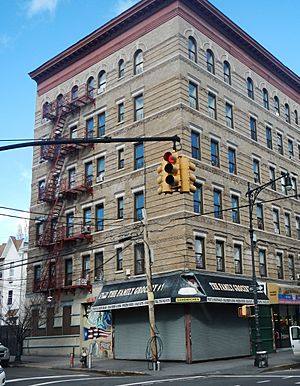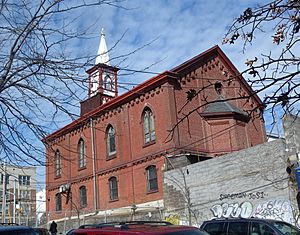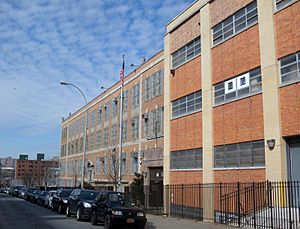Melrose, Bronx facts for kids
Quick facts for kids
Melrose
|
|
|---|---|
|
Neighborhood of the Bronx
|
|
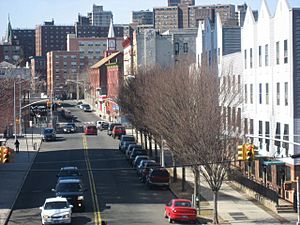
Looking west across St Ann's Avenue and along East 156th Street
|
|
| Country | |
| State | |
| City | |
| Borough | |
| Community District | Bronx 1 |
| Founded | 19th century |
| Named for | Melrose Abbey |
| Area | |
| • Total | 1.06 km2 (0.408 sq mi) |
| Population
(2011)
|
|
| • Total | 24,913 |
| • Density | 23,576/km2 (61,060/sq mi) |
| Economics | |
| • Median income | $24,467 |
| ZIP Codes |
10451, 10455, 10456
|
| Area code | 718, 347, 929, and 917 |
Melrose is a neighborhood in the southwestern part of the Bronx, a borough of New York City. It's mostly a place where people live. Melrose is located right next to The Hub, which is a busy area with shops and entertainment.
The neighborhood has a rectangular shape. It is bordered by Saint Anns Avenue to the east, 149th Street to the south, Park Avenue to the west, and 163rd Street to the north. Melrose Avenue and Third Avenue are the main streets that run through Melrose.
Melrose is part of Bronx Community Board 1. Its ZIP Codes are 10451, 10455, and 10456. The New York City Police Department's 40th Precinct helps keep the area safe. Public housing properties in Melrose are looked after by P.S.A. 7.
In the 1800s, many German American families lived here. Later, until the 1960s, it was home to many Irish and Italian families. Today, most residents are Latino. Melrose is considered part of the South Bronx area.
Contents
History of Melrose
Melrose was once a small village in the town of Morrisania, located in Westchester County. In 1874, it became part of New York City. At first, it was a busy neighborhood for working-class families. Many buildings were quickly built for immigrants moving from Manhattan around the early 1900s.
However, over time, some of these buildings became old and difficult to live in. In the 1960s and 1970s, the neighborhood faced many challenges. In 1973, the Third Avenue El, an elevated train line that used to bring people to the area, was taken down. By the 1980s, many buildings were empty, and some were even torn down.
Since the mid-1990s, Melrose has seen a lot of positive changes. A group called Nos Quedamos, which means "we stay" in English, has been very important in helping the neighborhood improve. Many old buildings have been fixed up, and new ones have been built.
Recently, there has been a lot of "Green" construction, meaning buildings are designed to be good for the environment. One example is Via Verde, a large apartment building that won an award in 2013 for its design. Melrose is also home to the Bronx campus of Boricua College. Even though some families still face challenges, Melrose has come a long way and is no longer a "forgotten" neighborhood.
Four historic churches in Melrose were built before 1900:
- The German Methodist Church (1878) at 790 Elton Ave.
- The German Reformed Church (1885) at 744 Elton Ave.
- Immaculate Conception Church (1887) at 389 E. 150th St.
- The German Lutheran Church (1895) at 376 E. 156th St.
The Melrose neighborhood has been growing since Jimmy Carter visited the Bronx in 1977. It is expected to keep growing as more land is developed.
In 2012, people living in Melrose were concerned about the Melrose Metro-North train station. They wanted more frequent train service, but the tracks and train capacity made this difficult. They also wanted better access for people with disabilities. The main entrance to the station used to be closed, but residents hope it will reopen to 161st Street, a main commercial street.
People and Community
Melrose is a densely populated neighborhood, meaning many people live there. Most residents are from Latin American or African American backgrounds.
According to the 2010 United States Census, the population of Melrose (including parts of Mott Haven) was about 39,214 people. This was a growth of over 6,000 people since the year 2000.
The neighborhood is very diverse. About 69% of the population is Hispanic or Latino. About 27% are African American, and 1.5% are White.
Most people in Melrose and Mott Haven are young or middle-aged adults. About 28% are under 18, and another 28% are between 25 and 44 years old.
Land Use and Buildings
Melrose has many large residential buildings, including public housing complexes and apartment buildings. Many of the older homes and apartments were damaged during tough times for the city and were later torn down. In recent years, new modern homes and apartment buildings have been built. This has led to more people owning their homes instead of renting.
Melrose has one of the largest numbers of NYCHA public housing projects in the Bronx. The area also has some hills.
The Third Avenue Shopping Area
The Hub-Third Avenue BID is a major shopping area. It's where five main streets meet: East 149th Street, Westchester, Willis, Melrose, and Third Avenues. You can get there using the 2 and 5 subway lines at East 149th Street and Third Avenue. It's one of the biggest shopping areas in the Bronx.
Public Housing Projects
There are five NYCHA developments in Melrose:
- East 152nd Street-Courtlandt Avenue: two buildings, 11 and 12 stories tall.
- Jackson Houses: seven 16-story buildings.
- Melrose Houses: eight 14-story buildings.
- Morrisania Air Rights: three buildings, 19, 23, and 29 stories tall.
- South Bronx Area (Site 402): four buildings, 3 stories tall.
In 2019, Park Avenue Green opened. It is the largest certified Passive House in North America, meaning it's built to be very energy efficient.
News and Media
The Mott Haven Herald is a local news source that covers Mott Haven, Melrose, and Port Morris. Students from the City University Graduate School of Journalism create it.
Fire and Emergency Services
Melrose has two New York City Fire Department (FDNY) fire stations:
- Engine Co. 71/Ladder Co. 55/Division 6 – 720 Melrose Avenue
- Squad 41 – 330 East 150th Street
FDNY EMS Station 14 is located at Lincoln Hospital at 234 East 149th Street. Another FDNY EMS Station 55 is at 3134 Park Avenue.
Post Offices and ZIP Codes
Melrose uses several ZIP Codes. Most of the neighborhood is in 10451. The southeastern part is in 10455, and the northeastern part is in 10456. The United States Postal Service has two post offices in Melrose:
- The Melcourt Station at 860 Melrose Avenue
- The Bronx Station at 558 Grand Concourse
Education
Melrose and Mott Haven have a lower rate of college-educated residents compared to other parts of New York City. As of 2018, about 16% of adults aged 25 and older have a college degree or higher.
The percentage of elementary school students in Melrose and Mott Haven who are often absent from school is higher than the city average. About 32% of elementary students miss 20 or more days of school each year. For high school students, about 62% graduate on time, which is lower than the city average.
Schools in Melrose
Public schools:
- PS 1: Courtlandt (East 152nd St and Courtlandt Avenue)
- PS 29: Melrose (East 156th St and Courtlandt Avenue)
- Alfred E. Smith High School (East 151st St and Courtlandt Avenue)
- Bronx Haven High School (East 151st St and Courtlandt Avenue)
Private schools:
- Immaculate Conception (378 E 151st St.)
- St. Peter and Paul (838 Brook Avenue)
- Boricua College (890 Washington Avenue)
Libraries
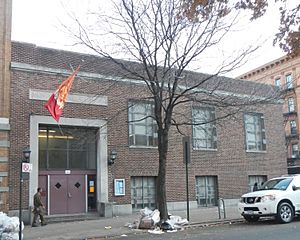
The New York Public Library has a branch in Melrose at 910 Morris Avenue. This library, a two-story building, opened in 1914. It was originally four stories tall, but the top two floors were removed during a renovation in 1959.
Transportation

Several MTA Regional Bus Operations bus routes serve Melrose:
- Bx2: travels to Mott Haven-136 Street or Kingsbridge Heights (using 149th Street and Grand Concourse)
- Bx4: goes to Third Avenue–149th Street or Westchester Square (using Westchester Avenue)
- Bx6 and Bx6 Select Bus Service: travels to Hunt's Point or Riverside Drive (using 161st and 163rd Streets)
- Bx15: connects to Fordham Plaza or The Hub (using Third Avenue)
- Bx19: goes to New York Botanical Garden or Riverbank State Park (using East 149th Street and Southern Boulevard)
- Bx21: travels to Westchester Square or Mott Haven (using Boston Road and Morris Park Avenue)
- Bx41 and Bx41 Select Bus Service: connects to Williamsbridge (using Webster Avenue)
The following New York City Subway stations are in Melrose:
- Third Avenue–149th Street (2 5 trains)
- Jackson Avenue (2 5 trains)
The Metro-North Railroad also has a stop at Melrose station. This local station on 162nd Street is part of the Harlem Line.
Notable People
Some well-known people who have lived in Melrose include:
- B-Lovee (born 2000), a drill rapper.
- Louis F. Haffen (1854–1935), an engineer and politician who was the first Bronx Borough President.
- Sha EK (born 2003), a drill artist.


